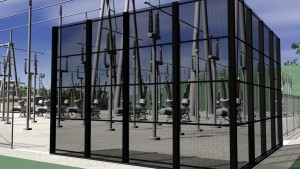 Two years ago, an attack on Pacific Gas & Electric’s Metcalf Substation took multiple power transformers offline in a matter of minutes and exposed vulnerabilities in our nation’s power grid. The North American Electric Reliability Corporation (NERC) responded by issuing the new CIP-014 Standards that requires substation owners and operators to take proactive measures to mitigate future physical attacks.
Two years ago, an attack on Pacific Gas & Electric’s Metcalf Substation took multiple power transformers offline in a matter of minutes and exposed vulnerabilities in our nation’s power grid. The North American Electric Reliability Corporation (NERC) responded by issuing the new CIP-014 Standards that requires substation owners and operators to take proactive measures to mitigate future physical attacks.
Many utilities are now focused on improving the physical security posture of their substations by implementing a hardened perimeter in accordance with Requirement R5.
To demonstrate compliance at critical substations, owners and operators across the U.S. are assessing their critical substation by October 1, defining a security plan and determining which physical security system is the best fit. So, what’s next? With those essential steps completed, it’s time to dive into implementation. Here’s a little more about what you can expect at each stage of the design and construction process.
Preliminary Design
The preliminary design lays the groundwork for what will become your overall design plan, taking into consideration a number of variables.
- Site Review: The first step is a site review involving all appropriate parties, including engineering, permitting, construction and security professionals. It’s important to involve everyone who has a hand in the project to avoid complications down the road. The engineering teams will identify potential conflicts, obstructions, civil features and site access modifications. At the same time, security professionals will review site access, potential station vulnerabilities and ideal monitoring locations for security systems. The permitting team will also assess any geographic location restrictions that might restrict the security systems deployed or delay the construction process.
- Stakeholder Input: Collaboration is a fundamental aspect of the preliminary design process. It’s important to discuss considerations from each stakeholder before moving on to a detailed plan. Notes collected will be used by the primary site review team and then analyzed and issued to create the station’s overall security plan, including outlining all enhancements being made to the substation perimeter. This process details any potential conflicts, clearance violations, security team considerations, asset modifications and concerns from permitting specialists.
- Surveying: Before plans are finalized and construction begins, multiple surveys will help mitigate any potential complications that might arise during construction. Accurate surveys will communicate all necessary design modifications to the engineering teams. These also safeguard against additional project costs by reducing the amount of material overage.
- Fabrication: After surveys are completed and plans approved, the engineering team will send the security plan to the perimeter manufacturer. While the perimeter material is fabricated, the engineering team will focus attention on the details of the design and the permitting team will engage with necessary parties about the project.
Detailed Design and Permitting Phase
This phase includes any plan modifications needed in order to finish the project.
- Design Reviews: As the engineers work through the detailed design process, creating a comprehensive plan typically includes several stages of coordination meetings and design reviews.
- Prompt Permitting: A fundamental aspect of the engineering coordination and communication process is promptness from the permitting teams. Information about local ordinances or project requirements should be disseminated as soon as possible. Each site location will have different perimeter installation requirements or restrictions, and some approvals only take a few weeks while others may take significantly longer. Anticipating these deliverables early in the permitting process will keep the project operating seamlessly and on schedule.
- Final Coordination: To make sure overall project goals have been met, a final project coordination meeting between engineering, security, permitting and construction is key to wrapping up the detailed design and permitting phase.
Construction Phase
There’s a lot more that goes into the construction phase than just building your perimeter.
- Communication: Consistent communication with the landowners surrounding the substation is crucial before and during the construction phase. With all the enhancements and changes to the physical appearance of the substation, property owners around the site will likely have questions. Each owner/operator should determine what message they want to convey to the public, anticipating potential feedback from the surrounding community. One simple solution to this is to station an on-site contact available to answer all potential inquiries.
- Working Practice Requirements: Before breaking ground, construction and permitting teams should address any limitations on working practices, including having the permitting team follow up with the construction coordinator about potential inspections.
For a more detailed look the processes described above and how it relates to the security needs at your substation, be sure to download my white paper, Defending the Edge: Considerations for Implementing Substation Perimeter Security.

